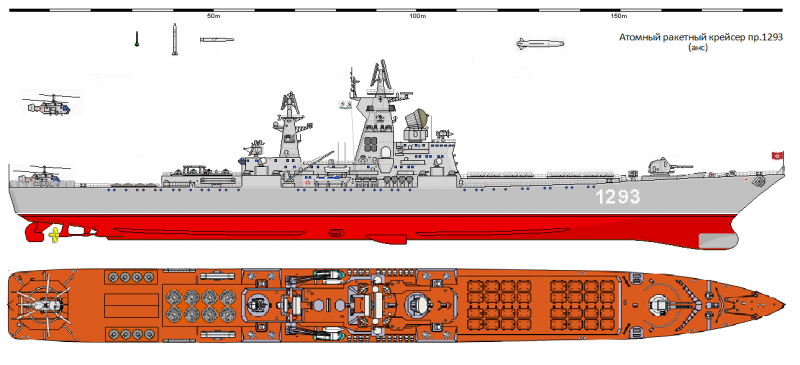Unrealized projects of the USSR Navy

The fact that the Project 1144 cruisers turned out to be large and expensive for a number of reasons was understood by admirals, designers, and shipbuilders. Therefore, the idea to make the ship a little smaller and, accordingly, cheaper appeared at the construction stage of the Kirov. This is how Project 1293 was born, which relied heavily on the previous project 1165.
The terms of reference for the design of these ships were issued to the Northern Design Bureau, and B.I. Kupensky (who had previously developed projects 50, 61 and the same 1144) was appointed chief designer. The resulting ship was slightly larger than Project 1164, but smaller than the Orlan. However, with the preservation of the nuclear power plant, since it was intended to accompany a nuclear aircraft carrier, which was already being prepared for construction in Nikolaev.
Approximate performance characteristics:
Displacement - 14 tons, length - 190 m, width - 210 m.
Armament: 16 vertical anti-ship missile launchers "Granit", collective defense air defense missile system "Fal" (modification of the air defense missile system "Fort") with ammunition of 64 missiles, air defense missile system "Dagger" with the same ammunition, two launchers of anti-aircraft missile system "Vodopad", two RBU-12000, twin universal 130-AU AK-130, four 30-mm six-barreled AK-630M assault rifles.
It should be noted that by this time, the new ships decided to abandon the 30-mm Kortik automatic anti-aircraft missile and artillery systems, due to their large weight and dimensions and the fact that in practice they did not have time to finish shooting with machine guns those not shot down with the help of their missiles enemy anti-ship missiles. Therefore, on the RKR Project 1293, interception in the near zone was carried out by the Kinzhal air defense system, and the completion of targets was carried out by ZAK AK-630 assault rifles, introduced into the general air defense circuit, but also with the possibility of individual guidance from its own radar. Two Ka-27 helicopters, with a stationary hangar in the stern.
On the basis of Project 1193, in order to unify the hull and power plant, they decided to develop a multifunctional air defense/anti-aircraft defense ship, Project 1199, code "Anchar". Initially, the ship was supposed to weigh 12 thousand tons, but then they decided to completely unify it with Project 1193. A later project had the same dimensions.
The first option with a nuclear power plant turned out to be not entirely successful in layout and was an air defense ship armed with three Uragan air defense systems with single-boom launchers, five Dirk combat modules (with one command module), a 130-mm universal twin gun and eight anti-ship missiles "Mosquito". Anti-submarine helicopter, one Ka-27, with a stationary hangar. Protection against enemy anti-ship torpedoes was to be provided by two RBU-6000 rocket launchers.
The project was supposed to be equipped with the most modern electronic weapons (from those available in the Soviet arsenal) fleet), including a long-range radar with a phased antenna array, a powerful sonar system, and an electronic warfare system. A gas turbine version of Project 1199 with enhanced air defense systems (Fal air defense missile system) was also developed by reducing the mass of the power plant; it was equipped with the Vodopad anti-ship missile system and the Moskit anti-ship missile system, the AK-630 ZAK and the Kinzhal air defense missile system, as more effective for providing short-range air defense/missile defense.
After recognizing that the development of a nuclear-powered missile cruiser of Project 1293 was inappropriate, the idea of unifying ships “in terms of hulls and power plants” was abandoned, as a result of which the main dimensions of Project 11990 were reduced to 188x19 m, and the displacement was reduced to 10 tons. The speed was about 500 knots. . That is, up to the parameters of project 32.
The air defense of the modified project consisted of 4 Uragan air defense systems, 6 Kinzhal air defense missile launchers and 4 Kortik BMs, which had different control systems. Anti-submarine weapons were strengthened: in addition to two permanently deployed helicopters and RBU-6000 rocket launchers, the ship was equipped with two long-range Vodopad anti-submarine missile launchers.
In the aft part of the ship, in the area of the Kinzhal air defense missile launcher, places were reserved on board for the new complex of anti-ship cruise missiles with a vertical launch (later Onyx) being developed, but “during the entire development of the project there was a long dispute about their necessity on this ship.” . The RBU-6000 installations were planned to be replaced in the future by the RKPTZ-1 (anti-torpedo defense rocket complex) “Udav”.
At the end of the 80s, in Nikolaev they even began cutting steel and issued orders for some units for the ship pr. 11990, but soon the work stopped.
The plant is already busy with work on the TAVKR and RKR Project 1164. It must be admitted that on these ships the ideas of universality have reached absurdity.
Alas, the collapse of the Union did not allow us to see what this would lead to.
Information